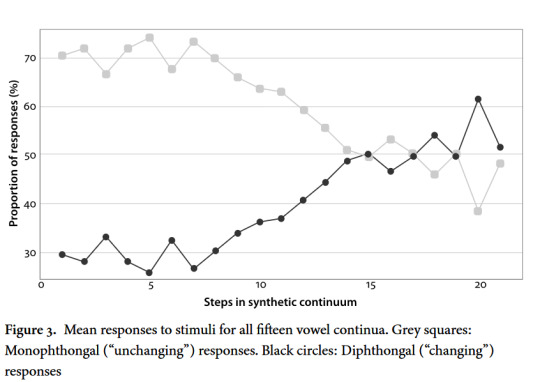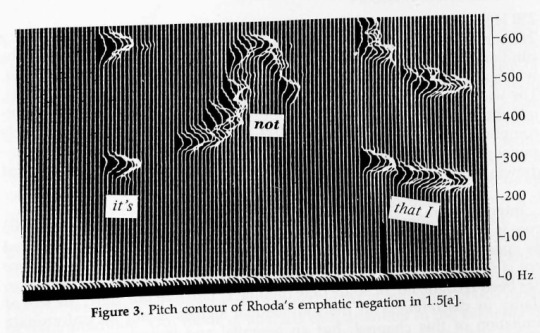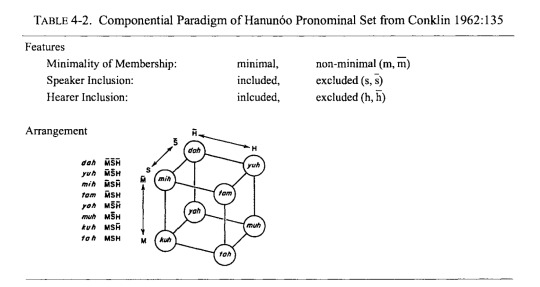Posting of language-related illustrations, such as tables, diagrams, maps, glossings, graphs, charts, schemas, paradigms, figures, lists and so on. #linguistics
Don't wanna be here? Send us removal request.
Text

Some isoglosses within the Germanic branch in a wave diagram.
From Trask's Historical Linguistics by Larry Trask (unknown edition)
Originally shared on Bluesky by @nathanielbdemiller.bsky.social
59 notes
·
View notes
Text

Family relationships between Dutch r variants. Place of articulation on the x-axis, manner of articulation on the y-axis.
Sebregts, Koen. 2015. The Sociophonetics and Phonology of Dutch r. LOT 379. (page 281)
38 notes
·
View notes
Text

These people created stimuli that are supposed to sound like the steps between a Proto-Germanic monophthong and the corresponding Old English diphthong, i.e., the x-axis is the degree of monophthongization to dipthongization. They then made listeners judge whether they heard a dipthong or monophthong (after som training).
Figure 3: Mean responses to stimuli for all fifteen vowel continua. Grey squares: Monophthongal ("unchanging") responses. Black circles: Diphthongal ("changing") responses.
Hudson, Toby, Jonathan Wei & John Coleman. 2024. Using acoustic-phonetic simulations to model historical sound change. Diachronica (not assigned issue/volume yet). https://doi.org/10.1075/dia.23019.hud.
#graph#line graph#phonetics#vowels#diphthong#Germanic#Diachronica#Toby Hudson#Jonathan Wei#John Coleman#2024#historical linguistics#John Benjamins#experiment#listening#perception#You seem to love this kind of graph
10 notes
·
View notes
Note
rytsas, I've been learning valyrian lately and got to the kinship terminology. As perplexing as it is I think I understood it. But why did the words for father and father's brother merge? Was the terminology in any way affected by the fact that the valyrians practiced incest? Are there words for grandparents? if not, is the dictionary growing? I have so many more questions... love your work, kirimvose.
The words didn’t merge: Children call their father kepa, and their father’s brother kepa. Valyrian’s is one of the six basic types of kinship systems—specifically the Iroquois system. If you haven’t seen this image before, this should explain it:

Only two of the systems actually use different terms for a maternal aunt and paternal uncle. The system we use in English happens to be one of those.
Also, for ease of reference, this is what the High Valyrian image looks like:

Though, of course, the vowel should be long in ñābranna.
The dictionary is always growing. I’ll continue to work on my languages till I’m dead.
Thanks for the ask!
219 notes
·
View notes
Text
Emojis count as linguistics, right?
Full reference: Mammola, Stefano, Mattia Flaschi & Gentile Francesco Ficetola. 2023. Biodiversity communication in the digital era through the Emoji tree of life. iScience 26(12). https://doi.org/10.1016/j.isci.2023.108569

Mammola et al. (2023)
H/t @dogreus for alerting us to this paper.
#emoji#phylogeny#tree#open access#iScience#Stefano Mammola#Mattia Flaschi#Gentile Francesco Ficetola#2023#biology#communication#unicode
6K notes
·
View notes
Text

Schematic diagram of a general general communication system - what has later become known as the "Shannon-Weaver-model". Historically important but also critisized.
Shannon, C. E. (July 1948). "A Mathematical Theory of Communication". Bell System Technical Journal. 27 (3): 381. doi:10.1002/j.1538-7305.1948.tb01338.x.
12 notes
·
View notes
Text
An illustration of prototypicity

Birdiness rankings.
Aitchison, Jean. 1994. Words in the mind: an introduction to the mental lexicon. Oxford, UK ; Cambridge, Mass., USA : Blackwell. http://archive.org/details/wordsinmindintro00aitc (3 February, 2022). Figure 5.1, page 54.
172 notes
·
View notes
Text

Table of the particles (ʔ)e, re, and (-ʔ)o in a number of African languages with description of the function(s) related to clause type marking in each language: vocative (VOC), imperative (IMP), interrogative (INTER), declarative (DECL) or subordination (SUB).
Fehn, Anne-Maria. 2024. “K’ui tii ‘Don’t speak!’ – Morphology and syntax of commands in Ts’ixa (Kalahari Khoe) and beyond”, Linguistique et langues africaines [Online], 10(1). URL: http://journals.openedition.org/lla/13288; DOI: https://doi.org/10.4000/123pu
#african language#Anne-Maria Fehn#clause#syntax#morphology#particles#Linguistique et langues africaine#linguistics#2024#Khwe#Ts'ixa#Shua#Tshwa#G|ui-G||ana#Naro#Nama#Hai||om#!Ora
11 notes
·
View notes
Photo
Ahearn, Laura. 2012. Living Language: An Introduction to Linguistic Anthropology. Wiley-Blackwell. doi:10.1002/9781444340563

my linguistic anthropology textbook getting pretty excited about this Chomsky knitting AU
#Laura Ahearn#linguistics#anthropology#Noam Chomsky#I think it has been referred to from other places#enough to be a meme#Wiley-Blackwell#Living Language
4K notes
·
View notes
Text

Pitch trace of the utterance "it's not that I", showing a peak on the negation not. A funky way of illustrating pitch? Pitch before Praat?
Labov, William & David Fanshel. 1977. Therapeutic discourse: psychotherapy as conversation. New York: Academic Press. [Figure 3, page 45]
A footnote explains the visualization this way: "Spectral Dynamics Real-Time Analyzer 301C with output displayed on a Tektronix 611 storage oscilloscope. The analyzer synthesizes 500 filters every 50 milliseconds over a variety of frequency ranges; the analysis can be terminated after any given number of filters and a new sweep started immediately. The pitch contour display used throughout this volume is made with a frequ ency range of 5,000 Hz. Each filter has a nominal bandwidth of 10 Hz and an effective bandwidth of 15 Hz. The sweep is terminated after the first 110 filters, so that a spectrum is generated every 11 milliseconds. The display on the oscilloscope is logarithmic and cuts off at 54 db below maximum. High-pass filtering at 12 db per octave begins at 3,000 Hz, and, in addition, the roll-off of the Nagra IV-S tape recorder - LS + FA - is used. Volume is then adjusted so that only the peaks of the wave forms are visible, thus tracing the path of the fundamental frequency without the interference of other signals"
#linguistics#phonetics#pitch#acoustics#William Labov#David Fanshel#1977#Therapeutic discourse#Academic Press
16 notes
·
View notes
Photo
Map where counties of Norway have been shaded reflecting the number of a specfic set of words containing palatalized n or l. By reddit user jkvatterholm.

Isoglosses for palatalisation of <n> and <l> in central Norway.
by jkvatterholm
66 notes
·
View notes
Text

Possible orderings of some derivational prefixes in Japhug. An arrow pointing from one circle to another means that the one being pointed to may follow it. Not all inner derivational prefixes are included here, likely (my own speculation) due to either rarity, or for the highly productive autive prefix, the fact that it can be infixed into the stem or other prefixes in some cases.Source is page 475. Jacques, Guillaume. 2021. A grammar of Japhug. (Comprehensive Grammar Library 1). Berlin: Language Science Press. DOI: 10.5281/zenodo.4548232 https://langsci-press.org/catalog/book/295
Submitted by @puddox
(CAUS = causative | RECIP = reciprocal | REFL = reflexive | FACIL = facilitative | PASS = passive | APASS = antipassive | APPL = applicative | TROP = tropative | PROP = proprietive)
#submission#puddox#Guillaume Jacquies#Japhug#Language Science Press#2021#I added the abbreviations because some of them are uncommon but I don't know what they all mean#A grammar of Japhug#Comprehensive Grammar Library#morphology#prefixes#derivation
14 notes
·
View notes
Text
Thank you for the serious comment that is not about the graph looking like big booty!

Duration of English /s/ as non-morphemic sound, plural morpheme, is-clitic or has-clitic (i.e ‘s).
Schmitz, Dominic. 2022. Production, perception, and comprehension of subphonemic detail: Word-Final /s/ in English. (Studies in Laboratory Phonology 11). Berlin: Language Science Press. DOI: 10.5281/zenodo.7267830 (page 50)
170 notes
·
View notes
Note
A Spanish sentence diagrammed and tagged with some syntactic terms in Spanish, by tumblr user strelnikov. 2024
dear olp. i really like linguistics when its stuff like your last hieroglyph post or the study of languages. but im really bad at syntax. i suspect its related to autism and sucking at math. i dont know if its taught in yank schools though. how did you learn to do it? ever have trouble with it?

oh i simply never retained any syntax beyond basic word order stuff. my syntactician colleagues are god's bravest soldiers.
#online#reblog#syntax#Spanish#tumblr#strelnikov#syntax advice:#if you read one book you know what that book says#if you read another you know a different book#if they agree you have won the lottery
125 notes
·
View notes
Text
stuff's been queued, but seems like I can't make the queue post at a random time within the specified range anymore? in any case, stay tuned
4 notes
·
View notes
Note

The Componential Paradigm of Hanunóo Pronominal Set (from Conklin 1962; taken from David Kronenfeld's Plastic Glasses and Church Fathers)
Full ref of a reprint: Conklin, Harold C. 1968. LEXICOGRAPHICAL TREATMENT OF FOLK TAXONOMIES. In: Fishman, J. ed. Readings in the Sociology of Language. Berlin, Boston: De Gruyter Mouton, pp. 414-433. https://doi.org/10.1515/9783110805376.414
The pronouns in question:
dah "they"
kuh "I"
mih "we"
muh "you"
tah "we two"
tam "we all"
yah "he, she"
yuh "you all"
Slightly complex, but I believe it's using Componential Semantics to account for the pronoun categories in Hanunó'o, a language spoken in the Phillipines, as an alternative to the traditional 1st-2nd-3rd person. The parameters are binary features (components): Two features regardinng whether the referent (group) includes the speaker (s) or hearer (h) - and then minimality (m), which the article does not seem to define explicitly, but the minimal version seems to be the one that contains "as few as possible" within the possible group, which essentials boils down to singulars and the dual "we two" . A letter with a line over means "not included" (e.g. s̅ means "excluding speaker").
THANK YOU FOR THE SUBMISSION
#Harold C. Conklin#1962#1968#Lexicography#Componential semantics#pronouns#Hanunoo#De Gruyter Mouton#person reference#clusivity#submission#epenethesis
15 notes
·
View notes
Text

List of relexifications in Inuit languages and Yupik due to modern language contact.
Abbreviations:
WG = West Greenlandic
CSY = Central Siberian Yupik
CAY = Central Alaskan Yupik
ECI = Eastern Canadian Inuktitiut
AI = Alaskan Inupiaq
Berge, A. & Kaplan, L. (2005). Contact-induced lexical development in Yupik and Inuit languages. Études/Inuit/Studies, 29(1-2), 285–305. https://doi.org/10.7202/013946ar
#Inuit#Yupik#list#Anna Berge#Lawrence Kaplan#words#meaning#Greenlandic#Aleut#Inuktitut#2005#Études/Inuit/Studies#AI#i guess
23 notes
·
View notes